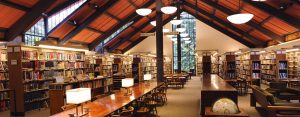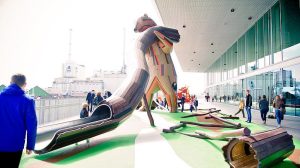Assignment X: Let There be Light

Library, noun.
1. A place set apart to contain books for reading, study, or reference. (Not applied, e.g. to the shop or warehouse of a bookseller.) In various applications more or less specific.
1.a. c.1374– Applied to a room in a house, etc.; also, †a bookcase. In modern use, the designation of one of the set of rooms ordinarily belonging to an English house above a certain level of size and pretension.
1.b. c.1449–A building, room, or set of rooms, containing a collection of books for the use of the public or of some particular portion of it, or of the members of some society or the like; a public institution or establishment, charged with the care of a collection of books, and the duty of rendering the books accessible to those who require to use them. (Oxford English Dictionary, n.d.)
The Oxford English Dictionary’s definition certainly looks familiar to the modern librarian or library patron. If we look to definition 1b, however, we see that the mission of the library and its relationship to the public hasn’t really changed since 1449. 1449! Angkor Wat was being built, as were the cliff houses at Mesa Verde. The pilgrims wouldn’t set foot in on Plymouth Rock for another hundred and seventy years. And yet even then the English were charging special locations with the care and welcome of the public for the accessibility of their book collections.
Fast forward 575 years, and we notice that the core purpose of the library is beginning to untangle itself, gently and not so gently, from its OED definition. While still welcoming of those who require access to books in a collection, libraries now welcome people who aren’t only looking for books, but also looking for and hoping to access the community in which they live. Or the community in which they participate. Or their online community. Or a community of makers. Of dreamers. Of helpers.
So then how do we define this new, interconnected library? Before doing so we must know our community, know who is using the library, and who isn’t. We have to be able to reach library users, all library users, even the ones who haven’t walked through the door, or haven’t opened their local library website. But how do we do that? And how do we know which doors to open? Or where to start?

Hyperlinked library services are born from the constant, positive, and purposeful adaptation to change that is based on thoughtful planning and grounded in the mission of libraries. (Stephens, n.d.)
Unlike the libraries of yore (literally!), modern libraries need to meet library users where they are, and to meet the challenges that their users face, ranging from boilerplate research questions to getting matched with social services. If the library is everywhere, and people are hyperlinks just as well as any technology and service (Stephens, n.d.), and the library aims to become the warp to the weft of the outside culture of the community, my main question becomes: How does the library itself retain and reframe its own identity and mission? If the goals of the hyperlinked library are, namely, to reach all users, even potential or lapsed ones, to provide skills, resources, and information to these users, to be an open and transparent organization without holding itself apart in some way (Stephens, n.d.), does it risk losing its identity as the mouth of the river of information? If “libraries are about people, not books or technology” (Matthews, 2012, p. 10), then how can we reorient the expectations placed upon them in this new environment?
Raging technological advances have allowed libraries to push the boundaries of what they can be. Adding on to book recommendations, reference question help, and summer reading programs, libraries offer a multitude of services and programs only tangentially related to books themselves: maker spaces, tool libraries/libraries of things, internet access and technology coaching, and teen spaces. The town square has moved indoors from the square to the library, one of the last remaining Third Places left in many communities. Providing the physical space for this meeting and information sharing promotes the understanding that “Third Places provide opportunities for a community to develop and retain a sense of cohesion and identity[…] they are about sociability, not isolation” (Leferink, 2018).

The price we pay for living in such a world is the obligation to shape it ourselves, making meaning out of the inchoate mass of information with which we are met. (Cassell & Hiremath, p. 326)
Information in community, getting resources where they need to go. Making meaning out of our work and our connections with others around us. To air out the stuffy, outmoded idea that the library can only accommodate a rarefied few, and shine a light on the people who make up our whole community. The hyperlinked library accommodates all the modalities of information sharing, and interconnectivity, that it can. If information is no longer the sole realm of the physical page, then the library, its librarians, and its patrons must follow suit and work with transparency, trust, and joy.
References
Cassell, K. A. & Hiremath, U. (2018). Reference and information services: An introduction (4thedition). ALA Neal-Schuman.
Kourlas, G. (2025, May 13). Dancing to the beating heart of a library’s collection. The New York Times. https://www.nytimes.com/2025/05/13/arts/dance/monica-bill-barnes-new-york-public-library.html?searchResultPosition=11
Leferink, S. (2018, January 24). To keep people happy… keep some books. Next. https://blog.oclc.org/next/to-keep-people-happy-keep-some-books/)
Matthews, B. (2012.) Facing the future. Virginia Tech. https://vtechworks.lib.vt.edu/server/api/core/bitstreams/77d2cb98-ddab-4543-9e47-b011819231b3/content
Oxford English Dictionary. (n.d.). Library. In Oxford English Dictionary online. Retrieved June 18, 2025, from https://www.oed.com/dictionary/library_n1?tab=meaning_and_use#additions
Stephens, M. (n.d.). “Historic” hyperlinked library model [Webinar]. San Jose State University. https://sjsu-ischool.hosted.panopto.com/Panopto/Pages/Viewer.aspx?id=a0569381-4d66-4e0a-a7fa-aab3010a8f3e
2 Comments
esperanza
Hi Mei,
First of all, what an an aesethetically pleasing post (and well written, of course)! I loved the mix of photos and quotes.
I appreciated you mentioning the library as a third space that people can still go to connect with one another. As you said, libraries are one of only few available third spaces left in many towns and cities. If we, as information professionals, lead with “transparency, trust, and joy,” we can continue to keep these third spaces for our communitites.
Mollie
Hi Mei, I know I’m a bit late on my comment here, but I kept scrolling back to this post because I really loved the way you wrote this, and I also thought the photos you added were really beautiful and cozy representations of what libraries can be. In the same way that books help us learn about the world through the perspectives of others, I think libraries help us do the same on a larger scale. Libraries are where we connect with people in our community who we may not have ever run into elsewhere. Libraries are where we can provide help in many forms to those that need it. Libraries are places where we can teach and where we can learn from others. I think you did an amazing job in this post of getting to the core of what libraries are now, and what they might be in the future. 🙂